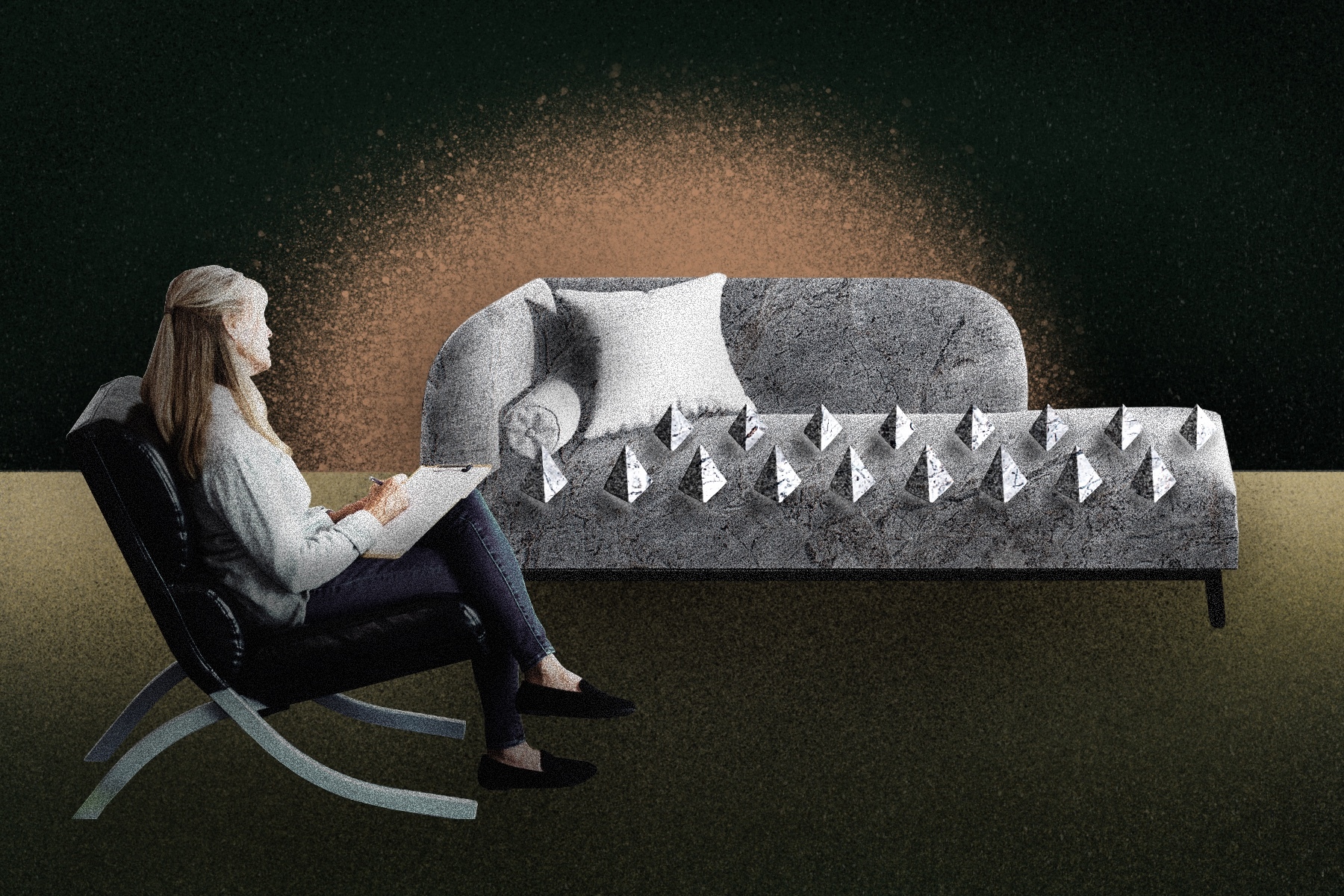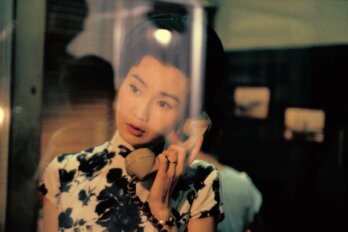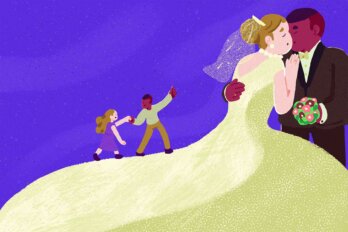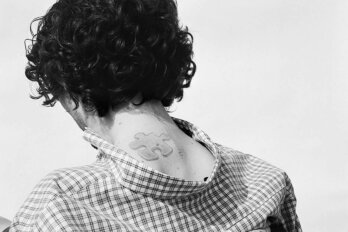A little while ago, I saw a post in my Toronto neighbourhood Facebook group about a man with “mental issues” hovering around a local park. The post also reminded us to “stay safe.” My neighbours said thanks for this warning, but my heart sank. I wondered who that man was and what had happened to him, about the events in his life that had led him to wander a public park with outward symptoms of mental illness. Maybe his gestures were sharp and pointed, his mind mired in what can only be assumed to be psychosis.
I wondered what my neighbours would think if they knew that I too had experienced severe mental health crises. I’d heard things that weren’t there, believed things that weren’t true, and lived with one foot in a semidelusional existence. Given the right mix of life events, I could have been that person wandering the park.
A lot has changed in the twenty years since I experienced my first episode. The conversation around mental illness has become productive, striving toward inclusivity and erasing stigma. Disability movements are more prolific and public. Research has not only provided some compelling theories about the underlying causes of and risk factors behind the onset of certain mental illnesses but has also allowed a wider range of explanations for social constructs about what is assumed to be deviant and abnormal behaviour. Whereas madness, lunacy, and insanity were shuttered behind locked doors in centuries past, new mental illness identities have filled a vacuum. Mad Pride has reclaimed ostracizing language. Today, some people talk about going to their therapist like they are going to the dentist.
But, even as the stigma around mental illness has faded, it has become clear that this compassion and effort extend only so far, and that they are not available to everyone. Often those fault lines appear around class—and around the type of mental illness. People who are perceived as productive members of society, who have jobs and who rent or own their homes, are, in some cases, allowed to be anxious, down, or depressed. Meanwhile, mental illnesses like schizophrenia, bipolar disorder, and substance use disorder, which result in behaviours that can be perceived as destructive and sometimes even violent, are not discussed as freely.
Some corporations have taken the lead in destigmatizing mental illness, but this has also allowed them to dictate what can be destigmatized. I also believe there’s more at work: our social and constructed institutions, rife with a history of treating madness as badness, are also to blame.
The first time I was taken to a psychiatric hospital was in the back of a police car. I had enough pills in my system to effectively and irreparably damage my liver if I didn’t receive medical attention soon, and my blood pH was dropping. I had waited alone in the emergency room for nearly an hour when I finally lost consciousness. I almost died that night, which I suppose was my intention. This was April 14, 2000.
The ride in the back of a police car had only affirmed my worthlessness, my otherness, the difference between me and “normal” people. I’d been walking through the previous few months in a dissociated haze, hardly sleeping, half of me believing that I was going to work miracles and the other half believing that the best thing for me was pushing up daisies.
Once stabilized, I was transferred (via police car) to a local psychiatric hospital, where I spent four days under constant surveillance. My actions were monitored: my tone of voice, my lowered gaze, the demure way I held my hands clasped in front of me because I knew if I behaved, I would be released sooner. My showers were supervised in a washroom that was a box lined with white tiles, silver buttons set into the walls, and no handles I could rip off or twist a piece of clothing around to hang myself. The mirror was brushed stainless steel, scratched over the years, and when I looked into it, all I could see looking back at me was the clouded face of a hollow person. There was no door to my room. The bars on the small window cut the afternoon sun into strips of pale light.
In that hospital, I learned who I really was. I wasn’t just a person who’d failed their second semester at university and was marched out of their dorm room accompanied by two police officers while students watched. I wasn’t a person who was terrified of what was happening to them. I was the Other, the sick, the deranged. I was crazy.
When I was discharged, I had no shoes or money to get home. I lied to the taxi driver that I could pay, but one look at my bare feet and we both knew this would be a free fare.
It wasn’t until I was thirty-four that I received an accurate diagnosis: bipolar disorder with rapid cycling (where moods shift quickly from depression to mania), social anxiety disorder, and agoraphobia. Within months of that diagnosis, I experienced a full-blown relapse. It took another two years to finally stabilize.
I shudder to think what would have happened to me if I’d lived just a few decades earlier.
William Hogarth’s 1735 etching, A Rake’s Progress, Plate 8, is a haunting rendition of the inside of Bethlem Royal Hospital in London, United Kingdom. In it, Hogarth depicts a chaotic array of mentally ill people. In the far left corner, someone lies on a bed, looking up with a wild look on his face, his body misshapen. To the right of that, a man is on the floor, being shackled by what looks to be asylum workers. He has an eerie smile on his face. Behind him is someone dressed in clownish clothes, emaciated and completely unaware of their surroundings. The scene is a twisted circus, something that would be placed in modern horror films and TV shows, like American Horror Story: Asylum. The chaos of the brain is mirrored in the chaos of the art, the themes of which have scaffolded many horror novels and films in the twentieth and twenty-first centuries. It looks almost as evilly fictitious as Batman’s Arkham Asylum, which housed super-villainous killers like the Joker, Two-Face, and Penguin. The depiction of patients as subhuman is as consistent in Arkham as in Hogarth’s interpretation of Bethlem Royal Hospital. In Hogarth’s etching, facial expressions of madness border on the demonic. To add to the degradation, for a fee, the public were allowed to tour inside the facility and witness madness. This is also apparent in the etching, with two ladies in the background in fine dress, whispering to each other in what looks like a gossiping, titillating way.
This mad identity is an antiquated and enduring belief that “madness is badness,” Geoffrey Reaume argues. Reaume is an associate professor teaching critical disability studies at the School of Health Policy and Management at York University, Toronto. He has spent decades uncovering and giving a platform to the stories of people who were patients at the Toronto Hospital for the Insane between 1870 and 1940. (The institution’s name changed several times during this period, though it’s now the Centre for Addiction and Mental Health, Queen Street Site.) This “madness is badness” is a centuries-old belief that has persevered, “to the extent that in the modern era, [madness] is generally believed as negative,” he says. These negative views are internalized and become part of one’s self-conception.
In the mid-nineteenth century, institutions were seen as progressive, both in policy and practice, and used segregation under the guise of protecting the public, perpetuating the myth that mental illness is synonymous with violence and evil. The state relieved families of their burdensome and insane loved one, who couldn’t contribute to a growing economy under industrialism and capitalism. Thus, a mad identity was interlaced with uselessness and danger, and institutions were the architects of this identity.
With mid-twentieth-century advancements in psychopharmaceuticals and the lessening of government interventions, deinstitutionalization swelled and the mentally ill were once again visible. But many people were left without a clear path forward: social support in both Canada and the US was thin. Where institutions had filled a gap, there was now a vacuum. In the 1960s and ’70s, previous psychiatric patients started filling that vacuum, demanding a reclamation of agency and identity. Disability and mad liberation movements began to crop up, organized and headed by the same folks who had an identity of lunacy and madness thrust upon them. Only, now, the “mad” label was worn with pride. These movements advocated for a shift in dialogue and policy that was so far removed from institutionalization as to be considered radical.
In 1993, Psychiatric Survivor Pride Day was organized as “one of the places crazy people got together to organize in Toronto,” according to disability justice advocate and author Leah Lakshmi Piepzna-Samarasinha. The event was subsequently rebranded as Mad Pride. The organization represented a seminal moment in mad liberation, reclaiming and deweaponizing language around a mentally ill identity.
But the perception of madness as synonymous with evil or shameful has never really faded. Film and television have perpetuated this stereotype, which can silence the people living with those mental illnesses that are often seen as more frightening, like the schizophrenia spectrum, bipolar disorders, and psychosis. News stories sensationalize violence in mentally ill people, rarely considering that folks with mental illness are far more likely to be victims of violence than to perpetrate it themselves. In the US, less than 4 percent of violent crimes are actually committed by severely mentally ill people, and in Canada, folks with serious mental illness experience violence at a rate four times higher than that for those without mental illness.
A report from the UK analyzed mental health references in television over a three-month time span. The results were both horrifying and unsurprising. Sixty-three percent of references weren’t just negative but were also derogative, pejorative, and unsympathetic. Words like “psycho,” “basket case,” and “crackpot” were peppered into conversations. This is very similar to the language used by public figures—politicians, media commentators, and even US presidents—in response to school shootings and particularly shocking violent crimes.
Conversely, rare mental illnesses, like agoraphobia, are portrayed in a mocking and comedic light. I still struggle with Joan Cusack’s Shameless character, Sheila Jackson, who exhibits an extreme form of agoraphobia, among other mental illnesses. Jackson is a stereotypical caricature of the unhinged mentally ill woman: needy, irrational, delusional, and seemingly incompetent (except when she’s baking dozens of muffins). I have a hard time reconciling this with my own perception of myself as someone living with agoraphobia. Is this who I am? I struggle with the stereotypical, broad-brushstroke depictions of anxiety disorders and phobias that assume they are all the same, that those who live with these mental illnesses are all the same.
In March 2014, I stood in the late-winter cold in downtown Toronto and watched as Clara Hughes embarked on her 12,000-kilometre cross-Canada bike ride in partnership with Bell Media to raise mental health awareness. As she spoke, I looked at my partner, tears in my eyes and hope in my heart. Here was someone big, someone famous, someone so normal who could speak for people like me. I was seen. I was heard. The hashtag #BellLetsTalk was coined, and every January after that, millions of dollars have been raised with every tweet, Bell Media call or text, Instagram video view, and Facebook filter. Celebrities like Howie Mandel, Mary Walsh, and Michael Landsberg started rallying for stigma erasure. Folks have used the hashtag as a way to go public with their mental illness diagnoses, from depression and anxiety to more serious ones such as bipolar disorder and schizophrenia. But these narratives are often focused on recovery, which is not always the reality for all sufferers. And yes, awareness did spread, but sort of like a wildfire that consumes all, leaving the most vulnerable behind.
I wish I’d spent just a moment with myself back in 2014 and realized how isolating this movement would become. How tiresome and seemingly pedantic. I would feel a small sense of relief if #BellLetsTalk brought justice for all mentally ill folks, instilled pride, and educated the public. But that’s not the world we live in, and the question that lingers, punctuated by too many police shootings, incarcerations, and continued racialization, is who exactly are these movements for? Who are the hashtags, the positivity movements, and endless memes counselling self-care for?
In mental health discourse, there is a strong underlying message that mental health is one’s own responsibility (self-care, expensive therapy, psychiatric intervention, and so on) and that mental unwellness—including mental illness—is something to be overcome, followed by a return to productivity within a capitalist world. And yet this is hardly ever unpacked within wider advocacy, such as #BellLetsTalk and CAMH’s 2020 campaign Not Suicide, Not Today. Instead, positivity campaigns are exclusive. They don’t include people that aren’t going to fit into an aspirational persona. Would #BellLetsTalk be open to having an unhoused person on its website, for example? For some, claiming a “mad” or “crazy” identity means their kids being taken away by the Children’s Aid Society, loss of employment, or the involvement of the criminal justice system.
According to studies in 2011 and 1998, four out of five incarcerated youth in British Columbia and Ontario met the criteria for at least one disorder listed in the Diagnostic and Statistical Manual of Mental Disorders (DSM), compared with 30.6 percent in the general population. About 15 to 20 percent of Indigenous people in federal facilities have attended residential schools. Do the positivity campaigns also talk about colonialism, oppression, and genocide?
With about a third of Canada’s incarcerated population being Indigenous, it hardly seems viable for Indigenous folks to claim a mentally ill identity when mental illness is so often perceived as synonymous with violence. Wellness checks—when police locate a person who may be in distress—can result in fatalities, as happened in 2020 to twenty-six-year-old Chantel Moore, who was an Indigenous woman shot and killed by a police officer in Edmundston, New Brunswick.
And what about Sammy Yatim? Or Edmond Yu, Ejaz Choudry, D’André Campbell? What identity is given to them other than that of victims of police killings?
On the surface, I fit the tidy criteria of mental illness. I can claim “mad” or “crazy” or call myself mentally ill with few repercussions. Despite losing opportunities and jobs and friends and years to mental illness, I can be public with my identity. In fact, my life has improved because I simply didn’t care to hide or defend myself anymore. I have been given a position in life that allows me to do what I need to do in order to live with my mental illness. And, for that, I am incredibly grateful. I can be who I am. I can be mentally ill. I can be mad. I can be crazy. I can be disabled. That identity is just one piece of my puzzle that, yes, defines me but is neither a good nor a bad thing. It just is. Identity is a place to rest.
But pause a moment and think: Who else can say the same? Who else needs this identity? Who else is allowed this identity? Maybe these are the questions we should really be asking.






